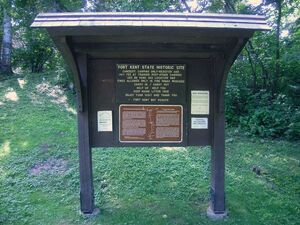
Fort Kent State Historic Site is a state park in Fort Kent, Maine.
History[]
The boundary between Maine and New Brunswick was a recurring subject of disagreement following the 1783 Treaty of Paris, in which Great Britain recognized the United States. Part of the eastern border was fixed after the Jay Treaty of 1797, but the upper Saint John River area remained disputed. Both Maine and New Brunswick pressed development of the area to solidify their claims, but this consequently raised tensions beginning in the 1820s, with authorities from each government acting against the other's settlers and agents.
Construction of Fort Kent, named for Governor Edward Kent, was begun in 1838 as tensions reached their height. It was one of a series of forts built by the state along the southern banks of the Saint John River, and is the only one surviving. (The blockhouse at Fort Fairfield is a 20th-century reconstruction.)
In 1839 the arrest of a US government agent in New Brunswick prompted Congress to authorize 50,000 federal troops for assignment to northern Maine. At this time the fort was enlarged to include barracks officers' quarters, and other buildings. General Winfield Scott was sent to the area with power to negotiate a settlement. Scott and New Brunswick Lieutenant Governor John Harvey, who had a long-established friendship, were able to successfully reduce tensions until the Webster-Ashburton Treaty was negotiated in 1842.
After the crisis passed, the fort was sold into private hands. In 1891 the property was sold to the state of Maine for the purpose of establishing a park. The state did no substantive work on the site until 1959, when the historic site was formally established. The museum is now maintained by the Fort Kent Historical Society.
Gallery[]
